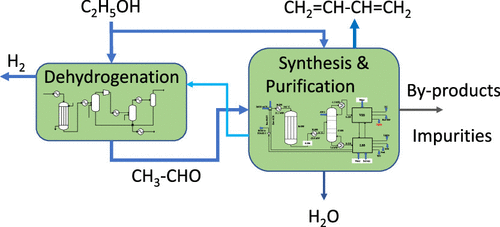当前位置:
X-MOL 学术
›
Ind. Eng. Chem. Res.
›
论文详情
Our official English website, www.x-mol.net, welcomes your
feedback! (Note: you will need to create a separate account there.)
Novel Two-Stage Process for Manufacturing Butadiene from Ethanol
Industrial & Engineering Chemistry Research ( IF 3.8 ) Pub Date : 2021-06-07 , DOI: 10.1021/acs.iecr.1c00958 Alexandre C. Dimian 1 , Nicoleta Ilona Bezedea 1 , Costin Sorin Bildea 1
Industrial & Engineering Chemistry Research ( IF 3.8 ) Pub Date : 2021-06-07 , DOI: 10.1021/acs.iecr.1c00958 Alexandre C. Dimian 1 , Nicoleta Ilona Bezedea 1 , Costin Sorin Bildea 1
Affiliation

|
Replacing petrochemicals with products obtained from renewable raw materials is a top challenge today. The paper deals with the design and simulation of a sustainable process for manufacturing butadiene from bioethanol with a capacity of 91,000 t/year. The two-stage process employs a selective CuO/Cr2O3 catalyst for ethanol dehydrogenation and recent yield-performant Ta2O5 catalyst for butadiene synthesis. The paper develops original flowsheets suitable for industrial implementation based on comprehensive kinetic models that provide a realistic description of the actual chemistry. The development of a complex separation system makes use of a systematic task-oriented methodology. Efficient separation methods are applied according to the chemical nature and physical properties of species for removing numerous impurities generated in reactions. The overall butadiene mass yield and carbon yield are 0.495 kg butadiene/kg ethanol (vs the maximum value 0.587) and 0.837, respectively. The catalyst productivity is 0.253 kg butadiene/kg cat·h. Substantial energy savings are achieved by heat recovery around the chemical reactors and by applying heat pumping for ethanol recovery and recycling. The sustainability analysis reveals low material intensity (0.227 kg waste/kg butadiene), moderate energy intensity (0.562 kW h/kg electrical energy and 15.8 MJ/kg thermal utilities), and low impact on the environment. The economic analysis pinpoints the possibility of achieving butadiene prices competitive with petrochemical products if the process is integrated in a biorefinery.
中文翻译:

从乙醇制造丁二烯的新型两步法
用可再生原材料获得的产品代替石化产品是当今的首要挑战。该论文涉及从生物乙醇生产丁二烯的可持续工艺的设计和模拟,其产能为 91,000 吨/年。两步法采用选择性 CuO/Cr 2 O 3催化剂进行乙醇脱氢和近期产率高的 Ta 2 O 5丁二烯合成催化剂。该论文基于综合动力学模型开发了适合工业实施的原始流程图,这些模型提供了对实际化学的真实描述。复杂分离系统的开发利用了系统的面向任务的方法。根据物种的化学性质和物理性质,采用有效的分离方法去除反应中产生的大量杂质。总体丁二烯质量产率和碳产率分别为 0.495 kg 丁二烯/kg 乙醇(相对于最大值 0.587)和 0.837。催化剂生产率为 0.253 kg 丁二烯/kg cat·h。通过在化学反应器周围进行热回收以及利用热泵进行乙醇回收和再循环,可以实现大量节能。可持续性分析显示材料强度低(0.227 千克废物/千克丁二烯)、能源强度中等(0.562 千瓦时/千克电能和 15.8 兆焦/千克热力设施)以及对环境的低影响。经济分析指出,如果将工艺整合到生物精炼厂中,丁二烯价格有可能与石化产品竞争。
更新日期:2021-06-17
中文翻译:

从乙醇制造丁二烯的新型两步法
用可再生原材料获得的产品代替石化产品是当今的首要挑战。该论文涉及从生物乙醇生产丁二烯的可持续工艺的设计和模拟,其产能为 91,000 吨/年。两步法采用选择性 CuO/Cr 2 O 3催化剂进行乙醇脱氢和近期产率高的 Ta 2 O 5丁二烯合成催化剂。该论文基于综合动力学模型开发了适合工业实施的原始流程图,这些模型提供了对实际化学的真实描述。复杂分离系统的开发利用了系统的面向任务的方法。根据物种的化学性质和物理性质,采用有效的分离方法去除反应中产生的大量杂质。总体丁二烯质量产率和碳产率分别为 0.495 kg 丁二烯/kg 乙醇(相对于最大值 0.587)和 0.837。催化剂生产率为 0.253 kg 丁二烯/kg cat·h。通过在化学反应器周围进行热回收以及利用热泵进行乙醇回收和再循环,可以实现大量节能。可持续性分析显示材料强度低(0.227 千克废物/千克丁二烯)、能源强度中等(0.562 千瓦时/千克电能和 15.8 兆焦/千克热力设施)以及对环境的低影响。经济分析指出,如果将工艺整合到生物精炼厂中,丁二烯价格有可能与石化产品竞争。































 京公网安备 11010802027423号
京公网安备 11010802027423号